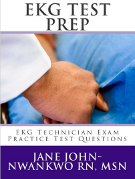Atrial Fibrillation ECG
The atrial fibrillation ECG is a common cardiac exam result observed by an electrocardiogram technician. Individuals who have this condition will experience a rapid and irregular cardiac contraction of the top two chambers. This type of activity overwhelms the sinoatrial node that would otherwise regulate an atrial contraction. Although a technician will not be required to provide an advanced medical evaluation of the examination results, it is worthwhile to have a very basic understanding of the disease and its wave characteristics.
Disease Mechanism
The mechanism of this condition is not completely understood, but is believed to occur as a result of a focused area of electrical activity might occur due to an increase in automaticity in the atria or near the pulmonary veins which requires a substrate for continuation and maintenance. The multiple wavelet theory states that waves travel aimlessly through the atria and may be maintained by re-entry circuits that result from the larger surface area of a dilated left atrium. Because the disorganized electrical activity of the atria does not travel through the atrioventricular node to the ventricles it does not cause a heartbeat. If all of the signals were allowed to pass through the node, they would likely result in ventricular tachycardia which would severely compromise cardiac output.
Common Wave Characteristics
An atrial fibrillation ECG pattern will show an absence of P waves along with a rhythm that is often irregularly irregular, variable ventricular rate, loss of an isoelectric baseline, fine or coarse fibrillatory waves, slow or fast ventricular response (normally somewhere between 110 and 160 beats per minute), Ashman’s phenomenon, and QRS complexes that are less than 120 milliseconds. The wide QRS complex might represent a ventricular tachycardia. Other studies such as an echocardiogram and Holter monitoring might be ordered after the electrocardiogram has been evaluated by a licensed medical professional.
Aside from wave characteristics seen on the atrial fibrillation ECG, technicians can expect patients to exhibit typical signs of inefficient circulation of blood through the body including palpitations, weakness, an inability to engage in physical exertion, lightheadedness, fatigue, chest pain, dizziness, confusion, and shortness of breath. Symptoms may be intermittent or persistent and may be treated using a variety of techniques depending on the condition of the patient and the judgment of a licensed physician. In general, the role of the technician is to perform the tests that are ordered and to ensure that the results are acceptable before passing them on to advanced providers for evaluation.

Source: http://www.aafp.org/afp/2011/0101/p61.html
Associated Causes
There are many conditions that are associated with atrial fibrillation including mitral stenosis, coronary artery disease, pericarditis, infection, electrolyte imbalances, hypertension, embolus, congenital diseases, an infection, hypertrophic cardiomyopathy, phaeochromocytoma, mitral regurgitation, thyrotoxicosis, pneumonia, and others. Signs, symptoms, medical history, and results of the atrial fibrillation ECG are used by the physician to make an informed decision about treatment. The diagnosis and treatment of patients is outside a technician’s scope.
Disease Classifications
Patients who present with atrial fibrillation are commonly classified according to a system established by the American College of Cardiology (ACC), the American Heart Association (AHA), and the European Society of Cardiology (ESC). The classification is determined by the presentation and duration of the condition. Every patient will initially be placed in the ‘first detected’ category regardless of duration and symptoms. The ‘paroxysmal’ category is reserved for individuals whose first episode lasts less than 7 days. Episodes lasting more than 7 days are unlikely to resolve on their own and move the patient into the ‘persistent’ classification. If an episode lasts for an extended period of time despite the cardioversion or other rhythm control efforts of the physician, then the patient is reclassified as permanent. Cases that are classified as permanent have episodes that last for more than a year. While the technician’s job is to provide an atrial fibrillation ECG, it is helpful to understand the classification system so that an individual understands the nature of a patient’s condition.
An Introduction to Treatment
The treatment process for patients suffering from atrial fibrillation is complex and might involve a variety of medical procedures that can include anticoagulation, cardioversion, an ablation, and surgery. The main objectives are to ensure cardiac stability and to reduce the chances of a stroke. Disorganized contraction of the atria can result in stasis and resultant thrombus formation. Anticoagulation strategies for preventing stroke might include using medications such as that of warfarin (Coumadin), clopidogrel, dabigatran, rivaroxaban, and aspirin. The physician will carefully consider the risk of a stroke and intracranial bleeding before using anticoagulation therapy.
The details outlined above should not have an affect on the ability of the technician to carry out their daily work responsibilities. While an individual in this profession is not required to have an advanced medical understanding of the diagnosis and treatment of heart disease, a basic appreciation of the processes being used can lead to a more satisfying career experience and will demonstrate a passion for high quality patient care. In addition, the knowledge that is acquired as a technician might later be used to advance one’s career as a licensed provider.





